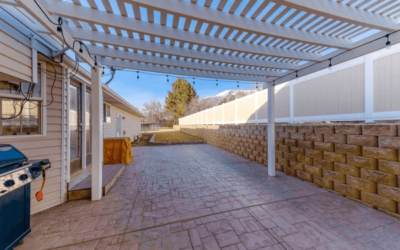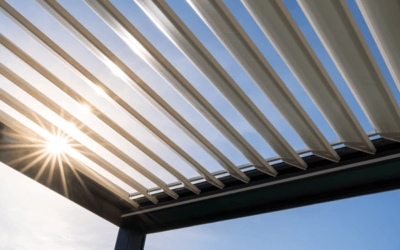What is a Pergola and Its Importance in Outdoor Design?
A pergola is an architectural feature commonly used in gardens and outdoor spaces to add both beauty and functionality. Typically constructed from columns that support crossbeams or rafters, pergolas provide shade and protection from the elements while still allowing natural light to filter through.
Enhancing the Aesthetic of Outdoor Spaces
Pergolas significantly elevate the aesthetic value of outdoor spaces with diverse designs that cater to all tastes. Whether traditional or modern, they introduce a unique charm that reflects the personality of the space’s owner. Moreover, they offer customization options through the choice of materials or climbing plants that can be integrated into the design.
Creating Outdoor Living Spaces
When combined with suitable furniture, a pergola transforms into a comfortable and inviting outdoor living area, ideal for family gatherings, relaxation, or even outdoor work. These spaces foster social interaction, offering a unique living experience that blends nature’s beauty with luxury.
Improving Privacy and Security
In addition to their aesthetic benefits, pergolas provide practical advantages, such as improving privacy in outdoor areas. They can be designed to create secluded, peaceful spaces away from prying eyes. Pergolas also enhance safety by offering shade from direct sunlight, increasing shaded areas in gardens or patios, making them perfect for enjoying the outdoors even on hot days.
Types of Pergolas and Their Various Uses
Pergolas come in various shapes and materials, each with distinct features suited to specific needs. Below are some popular types:
Wooden Pergolas
Wooden pergolas are among the most popular choices due to their natural beauty and seamless integration into most garden and outdoor designs. They offer comfortable shade and contribute to a warm, inviting atmosphere. However, they require regular maintenance to protect against weathering.
Metal Pergolas
Metal pergolas, crafted from materials like aluminum or steel, are known for their durability and strength. They are an excellent option for areas exposed to strong winds or heavy snow. Metal designs are versatile and can be painted in various colors to complement the surrounding décor. However, additional thermal insulation may be needed in hot climates to reduce heat absorption.
Fabric and Plastic Pergolas
Fabric or plastic pergolas provide a practical and cost-effective shading solution for those seeking temporary coverage. These types are easy to assemble and disassemble, making them ideal for events such as parties and outdoor gatherings. They are available in various shapes and colors to enhance the space’s appearance but may not be the best choice for areas prone to strong winds or harsh weather.
Materials Used in Pergola Construction
Pergolas can be made from various materials, each offering unique aesthetic appeal and durability. Choosing the right material depends on personal preference, budget, and the surrounding environment.
Wood
Wood is one of the most common materials for pergolas, prized for its natural and warm appearance. Popular woods include cedar, pine, and teak, known for their resistance to weather and pests. Regular maintenance, such as staining and sealing, is required to preserve wood’s appearance and extend its lifespan.
Metal
Aluminum and powder-coated steel are popular choices for pergola construction due to their strength and resistance to the elements. Metal pergolas are ideal for coastal and humid areas, as they are resistant to rust and decay. Their sleek, modern look suits contemporary home designs.
Vinyl
Vinyl is a low-maintenance material that withstands the elements well. Available in a variety of colors, it requires no painting or sealing, making it an excellent option for those seeking durability with minimal upkeep. Vinyl pergolas are long-lasting and ideal for homeowners who want a fuss-free, low-maintenance solution.
How to Properly Install a Pergola
Proper installation is crucial to ensure the safety and stability of a pergola. The process requires basic carpentry and construction skills.
Selecting the Right Location
Before installation, it is essential to choose a level, dry area free from water or gas lines to avoid potential damage during digging and construction. Additionally, the site should not obstruct walkways or interfere with the view of the garden.
Preparing Tools and Materials
Gather all necessary tools and materials before starting the installation. Tools may include a drill, hammer, measuring tape, level, and outdoor screws or bolts. Pre-assembled parts should be available, or wood and beams may need to be cut to the required size.
Building and Installation Process
The installation begins with securing concrete foundations in the designated locations for the pergola’s columns. Afterward, horizontal beams are attached to the columns, ensuring they are level and stable. At this stage, additional decorative elements or coverings can be added as desired. Ensuring all parts are securely fastened is essential for stability and durability.
Tips for Pergola Maintenance and Extending Its Lifespan
To maintain a pergola’s aesthetic and functionality, regular care is necessary. Following these maintenance tips will help extend its lifespan and ensure it remains a beautiful and functional feature for years to come.
Regular Cleaning
Cleaning the pergola regularly helps prevent dirt and debris from accumulating. A mild soap solution is often sufficient for most materials. After cleaning, ensure the pergola is thoroughly dried to prevent mold and mildew growth, particularly if it is made of wood.
Periodic Inspections
Routine inspections for wear and damage can help prevent more significant issues. Ensure that all components are secure and check for signs of weathering or decay. Wooden pergolas may require re-staining or treating for protection against moisture and pests.
Weather Protection
In areas with harsh weather, protecting the pergola is essential. Consider using protective covers during winter or storm seasons. Also, ensure proper drainage around the base to prevent water damage to the foundation or structure.



